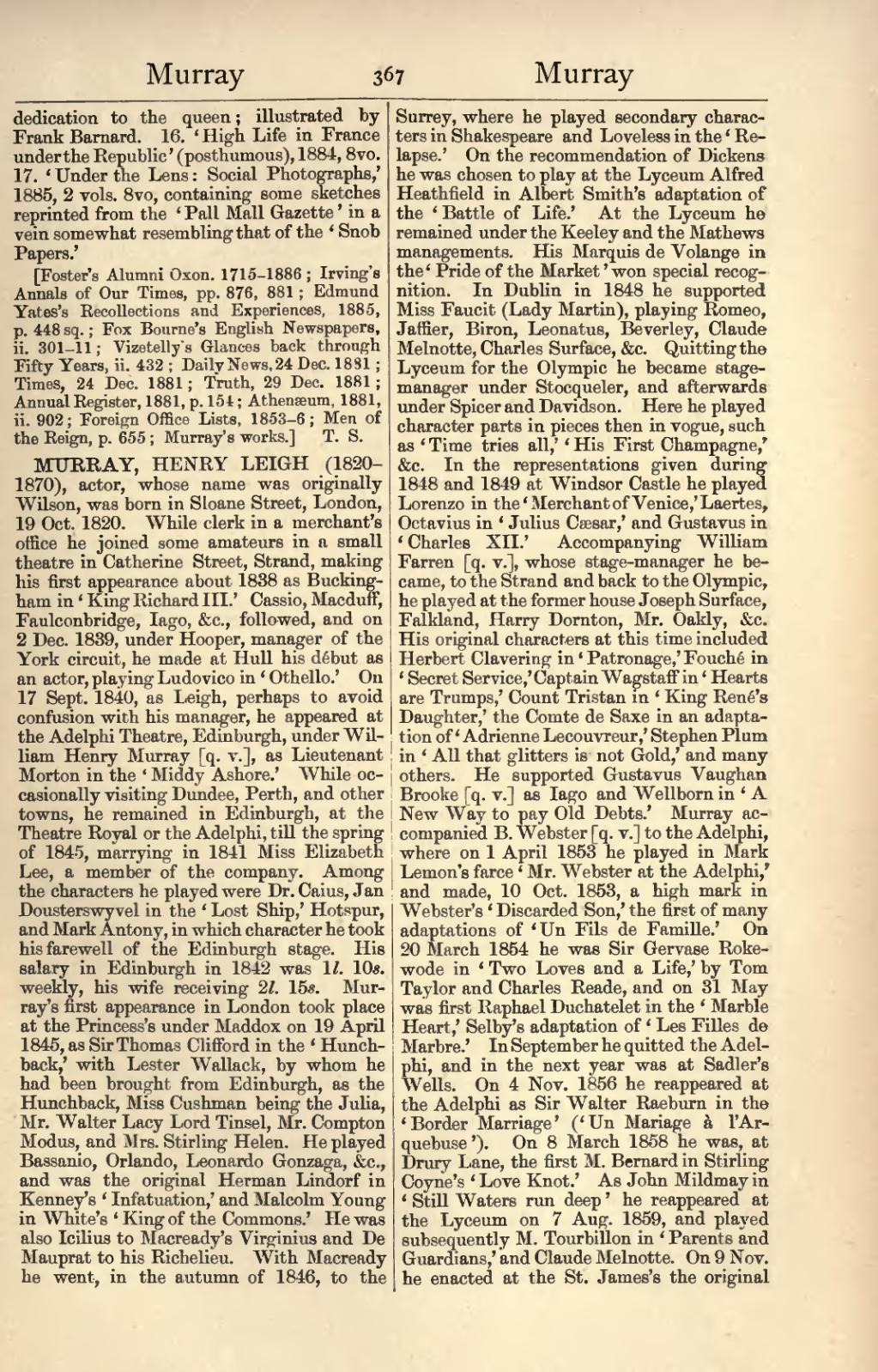dedication to the queen; illustrated by Frank Barnard. 16. 'High Life in France under the Republic' (posthumous), 1884, 8vo. 17. 'Under the Lens: Social Photographs,' 1885, 2 vols. 8vo, containing some sketches reprinted from the 'Pall Mall Gazette' in a vein somewhat resembling that of the 'Snob Papers.'
[Foster's Alumni Oxon. 1715-1886; living's Annals of Our Times, pp. 876, 881; Edmund Yates's Recollections and Experiences, 1885, p. 448 sq.; Fox Bourne's English Newspapers, ii. 301-11; Vizetelly's Glances back through Fifty Years, ii. 432; Daily News, 24 Dec. 1831; Times, 24 Dec. 1881; Truth, 29 Dec. 1881; Annual Register, 1881, p. 154; Athenæum, 1881, ii. 902; Foreign Office Lists, 1853-6; Men of the Reign, p. 655; Murray's works.]
MURRAY, HENRY LEIGH (1820–1870), actor, whose name was originally Wilson, was born in Sloane Street, London, 19 Oct. 1820. While clerk in a merchant's office he joined some amateurs in a small theatre in Catherine Street, Strand, making his first appearance about 1838 as Buckingham in 'King Richard III.' Cassio, Macduff, Faulconbridge, Iago, &c., followed, and on 2 Dec. 1839, under Hooper, manager of the York circuit, he made at Hull his debut as an actor, playing Ludovico in 'Othello.' On 17 Sept. 1840, as Leigh, perhaps to avoid confusion with his manager, he appeared at the Adelphi Theatre, Edinburgh, under William Henry Murray [q. v.], as Lieutenant Morton in the 'Middy Ashore.' While occasionally visiting Dundee, Perth, and other towns, he remained in Edinburgh, at the Theatre Royal or the Adelphi, till the spring of 1845, marrying in 1841 Miss Elizabeth Lee, a member of the company. Among the characters he played were Dr. Caius, Jan Dousterswyvel in the 'Lost Ship,' Hotspur, and Mark Antony, in which character he took his farewell of the Edinburgh stage. His salary in Edinburgh in 1842 was 1l. 10s. weekly, his wife receiving 2l. 15s. Murray's first appearance in London took place at the Princess's under Maddox on 19 April 1845, as Sir Thomas Clifford in the 'Hunchback,' with Lester Wallack, by whom he had been brought from Edinburgh, as the Hunchback, Miss Cushman being the Julia, Mr. Walter Lacy Lord Tinsel, Mr. Compton Modus, and Mrs. Stirling Helen. He played Bassanio, Orlando, Leonardo Gonzaga, &c., and was the original Herman Lindorf in Kenney's 'Infatuation,' and Malcolm Young in White's ' King of the Commons.' He was also Icilius to Macready's Virginius and De Mauprat to his Richelieu. With Macready he went, in the autumn of 1846, to the Surrey, where he played secondary characters in Shakespeare and Loveless in the 'Relapse.' On the recommendation of Dickens he was chosen to play at the Lyceum Alfred Heathfield in Albert Smith's adaptation of the ' Battle of Life.' At the Lyceum he remained under the Keeley and the Mathews managements. His Marquis de Volange in the 'Pride of the Market' won special recognition. In Dublin in 1848 he supported Miss Faucit (Lady Martin), playing Romeo, Jaffier, Biron, Leonatus, Beverley, Claude Melnotte, Charles Surface, &c. Quitting the Lyceum for the Olympic he became stage-manager under Stocqueler, and afterwards under Spicer and Davidson. Here he played character parts in pieces then in vogue, such as 'Time tries all,' 'His First Champagne,' &c. In the representations given during 1848 and 1849 at Windsor Castle he played Lorenzo in the 'Merchant of Venice,' Laertes, Octavius in 'Julius Caesar,' and Gustavus in 'Charles XII.' Accompanying William Farren [q. v.], whose stage-manager he became, to the Strand and back to the Olympic, he played at the former house Joseph Surface, Falkland, Harry Dornton, Mr. Oakly, &c. His original characters at this time included Herbert Clavering in 'Patronage,' Fouché in ' Secret Service,' Captain Wagstaff in 'Hearts are Trumps,' Count Tristan in 'King Rene's Daughter,' the Comte de Saxe in an adaptation of 'Adrienne Lecouvreur,' Stephen Plum in 'All that glitters is not Gold,' and many others. He supported Gustavus Vaughan Brooke [q. v.] as Iago and Wellborn in 'A New Way to pay Old Debts.' Murray accompanied B. Webster [q. v.] to the Adelphi, where on 1 April 1853 he played in Mark Lemon's farce 'Mr. Webster at the Adelphi,' and made, 10 Oct. 1853, a high mark in Webster's 'Discarded Son,' the first of many adaptations of 'Un Fils de Famille.' On 20 March 1854 he was Sir Gervase Rokewode in 'Two Loves and a Life,' by Tom Taylor and Charles Reade, and on 31 May was first Raphael Duchatelet in the 'Marble Heart,' Selby's adaptation of 'Les Filles de Marbre.' In September he quitted the Adelphi, and in the next year was at Sadler's Wells. On 4 Nov. 1856 he reappeared at the Adelphi as Sir Walter Raeburn in the 'Border Marriage' ('Un Mariage à l'Arquebuse'). On 8 March 1858 he was, at Drury Lane, the first M. Bernard in Stirling Coyne's 'Love Knot.' As John Mildmay in 'Still Waters run deep' he reappeared at the Lyceum on 7 Aug. 1859, and played subsequently M. Tourbillon in 'Parents and Guardians,' and Claude Melnotte. On 9 Nov. he enacted at the St. James's the original
